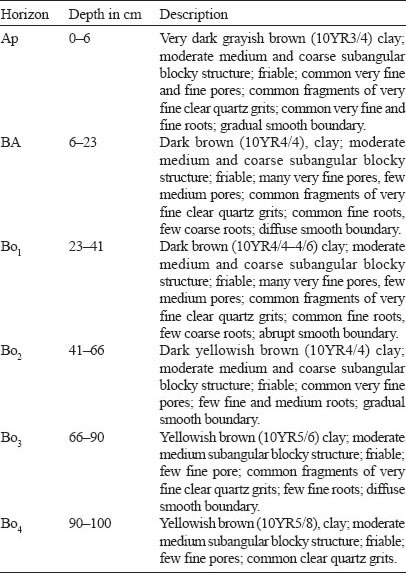Soil Profiles: Jarangan
Jarangan Series
The Jarangan Series is a member of the Munchong Family which is a very fine, kaolinitic, isohyperthermic, red-yellow Tipik Tempalemoks. It is developed over fine grained basic igneous rocks such as basalts. Soils of the Jarangan Series are characterized by their deep heavy clay textured oxic horizons with yellowish brown or strong brown colours at 50 cm depth. These oxic horizons have an ECEC of more than 1.5 cmol (+) kg–1 clay. Structures are weak medium to fine subangular blocky and consistence is friable
Type Location
Soils of the Jarangan Series were first established by Paton (1963) during the Reconnaissance Soil Survey of the Semporna Peninsula. The above pedon was described by staff of the Department of Agriculture Sabah in the Quoin Hill Agricultural Research Station near Tawau on undulating terrain (4–12% or 2– 6° slopes) at an elevation of 60 m (180 feet). Location: Topographic Sheet 4/118/ 9, 4°03’00” N, 118°01’30” E (Grid Reference 4/118/9 – 914836 m).
Range in Characteristics
Little is known about the range in characteristics of this soil. The colours range from yellowish brown to brownish yellow (10YR5/6, 5/8, 6/6, 6/8) to strong brown (7.5YR5/6, 5/8). Textures are uniformly clayey with more than 60% clay with some few fine clear quartz grits. The structures are weak medium to fine subangular blocky and consistence is friable. Soils of the Jarangan Series are deep (> 100 cm depth) and are well drained. Chemically as these soils are defined here they must have an ECEC of more than 1.5 cmol (+) kg–1 clay but less than 16 cmol. These soils have an oxic horizon.
Competing Soils and Their Differences
Soils of the Jarangan Series can easily be mistaken for many other soils which have an oxic or kandic horizons with heavy clay textures and brownish yellow to strong brown colours such as the Jerangau, Senai, Munchong, Katong and Tangga Series which are soils with oxic horizons and the Lanchang and Chat Series which have kandic horizons. Soils of the Jerangau and Senai Series are developed over granodiorite and gabbro parent material respectively and have an ECEC of less than 1.5 cmol (+) kg–1 clay. The Munchong, Katong and Tangga Series are similar to the Jarangan Series but are developed over shale, quartz andesite and limestone respectively. Both the Lanchang and Chat Series have a kandic horizon.
Setting
Soils of the Jarangan Series typically occur on undulating, rolling to hilly terrain (4–38% or 2–20° slopes) at elevations of less than 200 m (600 feet).
Principal Associated Soils
Soils of the Jarangan Series have till now been only mapped in the Tawau- Semporna and Telupid areas in Sabah. Being developed over intermediate to basic igneous rocks they have been mapped in association with soils of the Table, Apas and the Pinianakan Series. These soils are differentiated from the Jarangan Series using the colour and the parent material.
Drainage and Permeability
Soils of the Jarangan Series are generally well drained and have a rapid permeability.
Use and Vegetation
In the Tawau area in Sabah, where these soils have been mapped, these soils are mainly under oil palm and cocoa. Small areas are under primary forest.
Distribution and Extent
The Jarangan Series has to-date been only mapped in the Tawau and Telupid areas in Sabah. The actual extent of these soils is not known.
Series Established
This soil was established by Paton (1963) during the Reconnaissance Soil Survey of the Semporna Peninsula. The source of name is the Sungei Jarangan near Tawau.
Remarks on Classification
The Jarangan Series is classified here according to the Malaysian Soil Taxonomy – Second Approximation (Paramananthan 1998) as a member of the very fine, kaolinitic, isohyperthermic red-yellow family of Tipik Tempalemoks over basalt parent material. They are classified here as deep well drained soils that have heavy clay oxic horizons which have yellowish brown to strong brown colours and an ECEC of more than 1.5 cmol (+) kg–1 clay. In the Keys to Soil Taxonomy – Eighth Edition (Soil Survey Staff 1998), the Jarangan Series would probably be classified as Xanthic/Haplic Hapludox depending on the colour. In the FAO/UNESCO Soil Map of the World – Revised Legend (FAO 1990) the Jarangan Series would probably be classified as Xanthic/ Haplic Ferralsols depending on the colour.
Suitability for Agriculture
The main limitations for agriculture in these soils is the low fertility and the slope on which these soils occur. These soils should be suitable for a wide range of crops.



